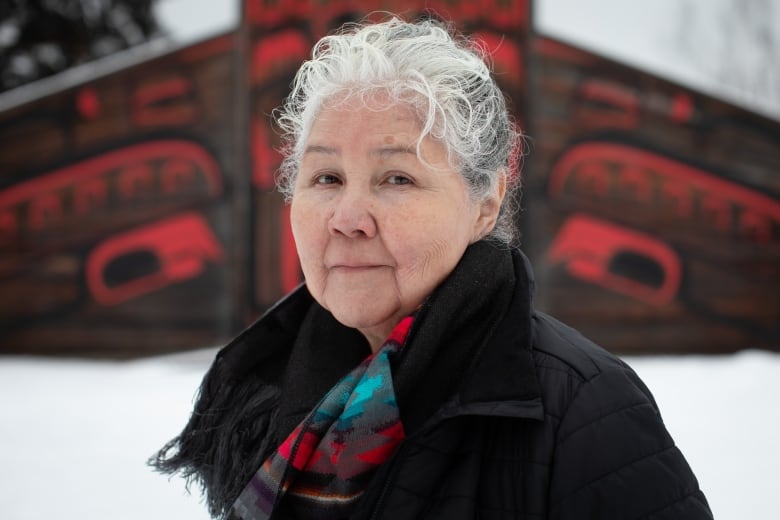Twenty-five years after the Delgamuukw verdict was handed down, First Nations’ leaders behind the historic case are still ruminating about how the land they fought for is still largely in the hands of the Crown.
“I thought the fight would have been over, but 25 years later, here we are still fighting,” said Dimdiigibuu, also known as Ardythe Wilson.
Dimdiigibuu was one of five speakers representing the Gitxsan and the Wet’suwet’en during the Delgamuukw vs. British Columbia trial, where the two nations fought to have their land title recognized.
She says government’s refusal to affirm Indigenous people’s title to the land is, in part, why there are still conflicts over land among Indigenous people, governments, companies and police and why the Crown still controls almost 90 per cent of land in Canada.
‘We never gave up our land’
In 1987, after years of failed negotiations with the provincial government over their claim of ownership and jurisdiction over 58,000 square kilometres of territory in northwest B.C., Gitxsan Hereditary Chiefs Delgamuukw and the Wet’suwet’en’s Gisday’wa brought their case to the B.C. Supreme Court.
But in 1991, Justice Allan McEachern ruled their title was extinguished when B.C. joined Confederation.
The two nations appealed in 1993.
“We never gave up our land. We never lost it in war. We never signed it away in treaty. It is still ours,” said Dimdiigibuu in her Gitanmaax community.
In 1997, the Gitxsan and the Wet’suwet’en took their fight to the Supreme Court of Canada.
And they won — to a degree.
A ‘bittersweet’ victory
The judges ruled that Indigenous people in British Columbia have ancestral land rights protected by section 35 (1) of the Constitution Act, 1982, which had not been extinguished when the province joined Confederation.
This means Aboriginal title was recognized as an “existing aboriginal right,” something that earlier drafts of the Constitution Act did not include.
It also confirmed Indigenous oral testimony as legitimate as other forms of evidence.
“That’s probably the greatest legacy of the case, that Indigenous law was uplifted,” said Merle Alexander, who observed the case as a law student in 1997 and is now a partner with the firm Miller Titerle.
The Delgamuukw ruling also established that the Gitxsan and Wet’suwet’en have systems of law that predate the days of elected band councils enacted under Canada’s Indian Act in 1876.
However, the ruling did not grant a declaration of Aboriginal land title.
“It’s one of those incredible, bittersweet victories,” said Alexander, adding that the case likely cost all parties hundreds of millions of dollars.
‘It’s shameful’: minister
Today, the Crown controls 89 per cent of land in Canada. The rest is primarily privately owned.
Indian reserves account for 0.2 per cent of Canada’s land mass, but under the Indian Act, First Nations peoples cannot own title to the land on their reserves. The Crown maintains legal authority on those lands.
Through land claims, Indigenous people hold approximately seven per cent of land in Canada, but legal scholars agree this number could be higher.
“What happened to the Delgamuukw case?” said Hanamaux, a Gitxsan Sim’oogit (Chief) who also goes by Don Ryan.
“The Constitution [Act] is 40 years old this year. The court case is 25 years old this year. What have you done about it?”
Even a federal minister has stated that the time to recognize Indigenous land title is overdue.
“It’s time to give land back,” said Marc Miller last fall in his first comments as the newly appointed minister of Crown-Indigenous relations.
“It’s shameful that today we haven’t moved as we should have in the mid-1990s when the Delgamuukw case was issued by the Supreme Court,” he said during the taping of CBC’s Land Back podcast in 2022.
Forced to push the envelope
The Delgamuukw case did set a precedent for other claims: in 2014, the Tŝilhqot’in used it in a ruling that led to the first declaration of Aboriginal title in Canada.
It’s one of hundreds of First Nations wins in court — one that Indigenous people have argued should have set a precedent for others to have their title to the land affirmed.
But being sent back to court, over and over, has pushed some to use additional avenues, like blockades, in their fight.
During the trial in the 1990s, Hanamaux says, Gitxsans took to blockading roads and railways to stop companies from helping themselves to Gitxsan lands.
“In some ways, that’s the only way they’d listen to us,” said Hanamaux from his home in Gitsegukla.
Today, blockading is a Gitxsan tradition, according to land defender Kolin Sutherland-Wilson.
“This rail line across Gitxsan territory has been blockaded for more than a hundred years,” said Sutherland-Wilson, standing on a stretch of tracks near Hazelton, B.C.
In 2021, Sutherland-Wilson, who is from the house Git’luuhl’um’hetxwit, and others blocked Canadian National Railway lines in solidarity with the Wet’suwet’en, who were protesting the Coastal GasLink pipeline on their traditional territory.
“It’s one of the very few mechanisms we have to actually push for justice on our lands because, you know, reconciliation hasn’t worked,” he said.
“We’ve gone to the highest courts in the land, we’ve gone right to the Crown, and it seems the only time there’s ever any type of progress is when we are forced to push the envelope as a last resort.”
As for the Crown: “Defining what title is, is some tragic unfinished business in Canada,” said Miller.
“But it’s time in my mind to start taking a risk, moving away from our positions of power, put our swords down and start working with the community to decide what that is.”

